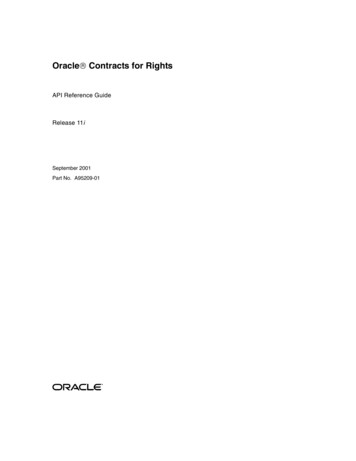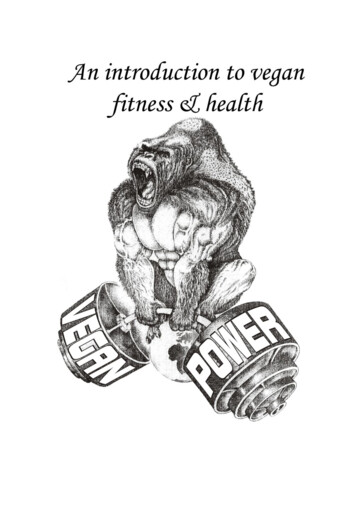
Transcription
Package ‘vegan’September 25, 2015Title Community Ecology PackageVersion 2.3-1Date 2015-09-24Author Jari Oksanen, F. Guillaume Blanchet, Roeland Kindt, Pierre Legendre,Peter R. Minchin, R. B. O'Hara, Gavin L. Simpson, Peter Solymos,M. Henry H. Stevens, Helene WagnerMaintainer Jari Oksanen jari.oksanen@oulu.fi Depends permute ( 0.8-0), lattice, R ( 2.15.0)Suggests parallel, tcltkImports MASS, cluster, mgcvDescription Ordination methods, diversity analysis and otherfunctions for community and vegetation ecologists.License GPL-2BugReports https://github.com/vegandevs/vegan/issuesURL http://cran.r-project.org, https://github.com/vegandevs/veganNeedsCompilation yesRepository CRANDate/Publication 2015-09-25 16:36:22R topics documented:vegan-packageadd1.cca . . . .adipart . . . . .adonis . . . . .anosim . . . . .anova.cca . . .as.mlm.cca . .BCI . . . . . .beals . . . . . .1.457111417192122
R topics documented:2betadisper . . . . .betadiver . . . . . .bgdispersal . . . .bioenv . . . . . . .biplot.rda . . . . .capscale . . . . . .cascadeKM . . . .cca . . . . . . . . .cca.object . . . . .CCorA . . . . . . .clamtest . . . . . .commsim . . . . .contribdiv . . . . .decorana . . . . . .decostand . . . . .designdist . . . . .deviance.cca . . . .dispindmorisita . .dispweight . . . . .distconnected . . .diversity . . . . . .dune . . . . . . . .dune.taxon . . . . .eigenvals . . . . .envfit . . . . . . .eventstar . . . . . .fisherfit . . . . . .goodness.cca . . .goodness.metaMDShumpfit . . . . . .indpower . . . . .isomap . . . . . . .kendall.global . . .linestack . . . . . .make.cepnames . .mantel . . . . . . .mantel.correlog . .MDSrotate . . . . .metaMDS . . . . .mite . . . . . . . .model.matrix.cca .monoMDS . . . . .MOStest . . . . . .mrpp . . . . . . . .mso . . . . . . . .multipart . . . . . .nestedtemp . . . .nobs.adonis . . . 129133135138141
R topics documented:nullmodel . . . . . .oecosimu . . . . . .ordiarrows . . . . . .ordiArrowTextXY . .ordihull . . . . . . .ordilabel . . . . . . .ordiplot . . . . . . .ordipointlabel . . . .ordiresids . . . . . .ordistep . . . . . . .ordisurf . . . . . . .orditkplot . . . . . .orditorp . . . . . . .ordixyplot . . . . . .pcnm . . . . . . . .permat . . . . . . . .permustats . . . . . .permutations . . . .permutest.betadisperplot.cca . . . . . . .prc . . . . . . . . . .predict.cca . . . . . .procrustes . . . . . .pyrifos . . . . . . . .radfit . . . . . . . . .rankindex . . . . . .rarefy . . . . . . . .raupcrick . . . . . .read.cep . . . . . . .renyi . . . . . . . . .reorder.hclust . . . .RsquareAdj . . . . .scores . . . . . . . .screeplot.cca . . . . .simper . . . . . . . .simulate.rda . . . . .sipoo . . . . . . . . .spantree . . . . . . .specaccum . . . . . .specpool . . . . . . .SSarrhenius . . . . .stepacross . . . . . .stressplot.wcmdscaletaxondive . . . . . .tolerance . . . . . . .treedive . . . . . . .tsallis . . . . . . . .varespec . . . . . . 21222225227229229232236240242244246248249251254
4vegan-packagevarpart . . . . . .vegan-deprecatedvegandocs . . . .vegdist . . . . . .vegemite . . . . .wascores . . . . .wcmdscale . . . ity Ecology Package: Ordination, Diversity and DissimilaritiesDescriptionThe vegan package provides tools for descriptive community ecology. It has most basic functionsof diversity analysis, community ordination and dissimilarity analysis. Most of its multivariate toolscan be used for other data types as well.DetailsThe functions in the vegan package contain tools for diversity analysis (see vignette vegandocs("diversity")),ordination and analysis of dissimilarities (see vignette vegandocs("intro")). Together with thelabdsv package, the vegan package provides most standard tools of descriptive community analysis. Package ade4 provides an alternative comprehensive package, and several other packagescomplement vegan and provide tools for deeper analysis in specific fields. Package BiodiversityRprovides a GUI for a large subset of vegan functionality.The vegan package is developed at GitHub (https://github.com/vegandevs/vegan/). GitHubprovides up-to-date information and forums for bug reports.The vegan documents can be read with vegandocs function. In addition to vignettes of basic usage, you can read NEWS on the new features and bug fixes in the release version (vegandocs("NEWS")),and more technical and fine grained ChangeLog (vegandocs("Change")). Several frequently askedquestions really are answered in the vegan FAQ (vegandocs("FAQ")). The discussion on design decisions can be read with vegandocs("decision"). A tutorial of the package at http://cc.oulu.fi/ jarioksa/opetus/metodi/vegantutor.pdf provides a more thorough introduction to thepackage.To see the preferable citation of the package, type citation("vegan").Author(s)The vegan development team is Jari Oksanen, F. Guillaume Blanchet, Roeland Kindt, Pierre Legendre, Peter R. Minchin, R. B. O’Hara, Gavin L. Simpson, Peter Solymos, M. Henry H. Stevens,Helene Wagner. Many other people have contributed to individual functions: see credits in functionhelp pages.
add1.cca5Examples### Example 1: Unconstrained ordination## NMDSdata(varespec)data(varechem)ord - metaMDS(varespec)plot(ord, type "t")## Fit environmental variablesef - envfit(ord, varechem)efplot(ef, p.max 0.05)### Example 2: Constrained ordination (RDA)## The example uses formula interface to define the modeldata(dune)data(dune.env)## No constraints: PCAmod0 - rda(dune 1, dune.env)mod0plot(mod0)## All environmental variables: Full modelmod1 - rda(dune ., dune.env)mod1plot(mod1)## Automatic selection of variables by permutation P-valuesmod - ordistep(mod0, scope formula(mod1))modplot(mod)## Permutation test for all variablesanova(mod)## Permutation test of "type III" effects, or significance when a term## is added to the model after all other termsanova(mod, by "margin")## Plot only sample plots, use different symbols and draw SD ellipses## for Managemenet classesplot(mod, display "sites", type "n")with(dune.env, points(mod, disp "si", pch as.numeric(Management)))with(dune.env, legend("topleft", levels(Management), pch 1:4,title "Management"))with(dune.env, ordiellipse(mod, Management, label TRUE))## add fitted surface of diversity to the modelordisurf(mod, diversity(dune), add TRUE)### Example 3: analysis of dissimilarites a.k.a. non-parametric### permutational anovaadonis(dune ., dune.env)adonis(dune Management Moisture, dune.env)add1.ccaAdd or Drop Single Terms to a Constrained Ordination Model
6add1.ccaDescriptionCompute all single terms that can be added to or dropped from a constrained ordination model.Usage## S3 method for class 'cca'add1(object, scope, test c("none", "permutation"),permutations how(nperm 199), .)## S3 method for class 'cca'drop1(object, scope, test c("none", "permutation"),permutations how(nperm 199), .)ArgumentsobjectA constrained ordination object from cca, rda or capscale.scopeA formula giving the terms to be considered for adding or dropping; see add1for details.testShould a permutation test be added using anova.cca.permutationsa list of control values for the permutations as returned by the function how, orthe number of permutations required, or a permutation matrix where each rowgives the permuted indices.Other arguments passed to add1.default, drop1.default, and anova.cca.DetailsWith argument test "none" the functions will only call add1.default or drop1.default. Withargument test "permutation" the functions will add test results from anova.cca. Functiondrop1.cca will call anova.cca with argument by "margin". Function add1.cca will implementa test for single term additions that is not directly available in anova.cca.Functions are used implicitly in step, ordiR2step and ordistep. The deviance.cca and deviance.rdaused in step have no firm basis, and setting argument test "permutation" may help in getting useful insight into validity of model building. Function ordistep calls alternately drop1.ccaand add1.cca with argument test "permutation" and selects variables by their permutationP -values. Meticulous use of add1.cca and drop1.cca will allow more judicious model building.The default perm.max is set to a low value, because permutation tests can take a long time. It shouldbe sufficient to give a impression on the significances of the terms, but higher values of perm.maxshould be used if P values really are important.ValueReturns a similar object as add1 and drop1.Author(s)Jari Oksanen
adipart7See Alsoadd1, drop1 and anova.cca for basic methods. You probably need these functions with step andordistep. Functions deviance.cca and extractAIC.cca are used to produce the other argumentsthan test results in the output. Functions cca, rda and capscale produce result objects for thesefunctions.Examplesdata(dune)data(dune.env)## Automatic model building based on AIC but with permutation testsstep(cca(dune 1, dune.env), reformulate(names(dune.env)), test "perm")## see ?ordistep to do the same, but based on permutation P-values## Not run:ordistep(cca(dune 1, dune.env), reformulate(names(dune.env)), perm.max 200)## End(Not run)## Manual model building## -- define the maximal model for scopembig - rda(dune ., dune.env)## -- define an empty model to start withm0 - rda(dune 1, dune.env)## -- manual selection and updatingadd1(m0, scope formula(mbig), test "perm")m0 - update(m0, . . Management)add1(m0, scope formula(mbig), test "perm")m0 - update(m0, . . Moisture)## -- included variables still significant?drop1(m0, test "perm")add1(m0, scope formula(mbig), test "perm")adipartAdditive Diversity Partitioning and Hierarchical Null Model TestingDescriptionIn additive diversity partitioning, mean values of alpha diversity at lower levels of a sampling hierarchy are compared to the total diversity in the entire data set (gamma diversity). In hierarchicalnull model testing, a statistic returned by a function is evaluated according to a nested hierarchicalsampling design (hiersimu).Usageadipart(.)## Default S3 method:adipart(y, x, index c("richness", "shannon", "simpson"),weights c("unif", "prop"), relative FALSE, nsimul 99, .)## S3 method for class 'formula'
8adipartadipart(formula, data, index c("richness", "shannon", "simpson"),weights c("unif", "prop"), relative FALSE, nsimul 99, .)hiersimu(.)## Default S3 method:hiersimu(y, x, FUN, location c("mean", "median"),relative FALSE, drop.highest FALSE, nsimul 99, .)## S3 method for class 'formula'hiersimu(formula, data, FUN, location c("mean", "median"),relative FALSE, drop.highest FALSE, nsimul 99, .)ArgumentsyA community matrix.xA matrix with same number of rows as in y, columns coding the levels of sampling hierarchy. The number of groups within the hierarchy must decrease fromleft to right. If x is missing, function performs an overall decomposition intoalpha, beta and gamma diversities.formulaA two sided model formula in the form y x, where y is the community datamatrix with samples as rows and species as column. Right hand side (x) must begrouping variables referring to levels of sampling hierarchy, terms from right toleft will be treated as nested (first column is the lowest, last is the highest level,at least two levels specified). Interaction terms are not allowed.dataA data frame where to look for variables defined in the right hand side offormula. If missing, variables are looked in the global environment.indexCharacter, the diversity index to be calculated (see Details).weightsCharacter, "unif" for uniform weights, "prop" for weighting proportional tosample abundances to use in weighted averaging of individual alpha valueswithin strata of a given level of the sampling hierarchy.relativeLogical, if TRUE then alpha and beta diversity values are given relative to thevalue of gamma for function adipart.nsimulNumber of permutations to use if matr is not of class ’permat’. If nsimul 0,only the FUN argument is evaluated. It is thus possible to reuse the statistic valueswithout using a null model.FUNA function to be used by hiersimu. This must be fully specified, because currently other arguments cannot be passed to this function via .locationCharacter, identifies which function (mean or median) is to be used to calculatelocation of the samples.drop.highestLogical, to drop the highest level or not. When FUN evaluates only arrays withat least 2 dimensions, highest level should be dropped, or not selected at all.Other arguments passed to functions, e.g. base of logarithm for Shannon diversity, or method, thin or burnin arguments for oecosimu.
adipart9DetailsAdditive diversity partitioning means that mean alpha and beta diversities add up to gamma diversity, thus beta diversity is measured in the same dimensions as alpha and gamma (Lande 1996).This additive procedure is then extended across multiple scales in a hierarchical sampling designwith i 1, 2, 3, . . . , m levels of sampling (Crist et al. 2003). Samples in lower hierarchical levelsare nested within higher level units, thus from i 1 to i m grain size is increasing under constantsurvey extent. At each level i, αi denotes average diversity found within samples.At the highest sampling level, the diversity components are calculated asβm γ αmFor each lower sampling level asβi αi 1 αiThen, the additive partition of diversity isγ α1 mXβii 1Average alpha components can be weighted uniformly (weight "unif") to calculate it as simpleaverage, or proportionally to sample abundances (weight "prop") to calculate it as weighted average as followsniXαi Dij wijj 1where Dij is the diversity index and wij is the weight calculated for the jth sample at the ithsampling level.The implementation of additive diversity partitioning in adipart follows Crist et al. 2003. It isbased on species richness (S, not S 1), Shannon’s and Simpson’s diversity indices stated as theindex argument.The expected diversity components are calculated nsimul times by individual based randomisationof the community data matrix. This is done by the "r2dtable" method in oecosimu by default.hiersimu works almost in the same way as adipart, but without comparing the actual statisticvalues returned by FUN to the highest possible value (cf. gamma diversity). This is so, because inmost of the cases, it is difficult to ensure additive properties of the mean statistic values along thehierarchy.ValueAn object of class "adipart" or "hiersimu" with same structure as oecosimu objects.Author(s)Péter Sólymos, solymos@ualberta.ca
10adipartReferencesCrist, T.O., Veech, J.A., Gering, J.C. and Summerville, K.S. (2003). Partitioning species diversityacross landscapes and regions: a hierarchical analysis of α, β, and γ-diversity. Am. Nat., 162,734–743.Lande, R. (1996). Statistics and partitioning of species diversity, and similarity among multiplecommunities. Oikos, 76, 5–13.See AlsoSee oecosimu for permutation settings and calculating p-values. multipart for multiplicative diversity partitioning.Examples## NOTE: 'nsimul' argument usually needs to be 99## here much lower value is used for ## Function to get equal area partitions of the mite datacutter - function (x, cut seq(0, 10, by 2.5)) {out - rep(1, length(x))for (i in 2:(length(cut) - 1))out[which(x cut[i] & x cut[(i 1)])] - ireturn(out)}## The hierarchy of sample aggregationlevsm - with(mite.xy, data.frame(l1 1:nrow(mite),l2 cutter(y, cut seq(0, 10, by 2.5)),l3 cutter(y, cut seq(0, 10, by 5)),l4 cutter(y, cut seq(0, 10, by 10))))## Let's see in a mappar(mfrow c(1,3))plot(mite.xy, main "l1", col as.numeric(levsm l1) 1, asp 1)plot(mite.xy, main "l2", col as.numeric(levsm l2) 1, asp 1)plot(mite.xy, main "l3", col as.numeric(levsm l3) 1, asp 1)par(mfrow c(1,1))## Additive diversity partitioningadipart(mite, index "richness", nsimul 19)adipart(mite ., levsm, index "richness", nsimul 19)## Hierarchical null model testing## diversity analysis (similar to adipart)hiersimu(mite, FUN diversity, relative TRUE, nsimul 19)hiersimu(mite ., levsm, FUN diversity, relative TRUE, nsimul 19)## Hierarchical testing with the Morisita indexmorfun - function(x) dispindmorisita(x) imsthiersimu(mite ., levsm, morfun, drop.highest TRUE, nsimul 19)
adonisadonis11Permutational Multivariate Analysis of Variance Using Distance MatricesDescriptionAnalysis of variance using distance matrices — for partitioning distance matrices among sources ofvariation and fitting linear models (e.g., factors, polynomial regression) to distance matrices; uses apermutation test with pseudo-F ratios.Usageadonis(formula, data, permutations 999, method "bray",strata NULL, contr.unordered "contr.sum",contr.ordered "contr.poly", parallel getOption("mc.cores"), .)Argumentsformulaa typical model formula such as Y A B*C, but where Y is either a dissimilarity object (inheriting from class "dist") or data frame or a matrix; A, B, andC may be factors or continuous variables. If a dissimilarity object is supplied, nospecies coefficients can be calculated (see Value below).datathe data frame from which A, B, and C would be drawn.permutationsa list of control values for the permutations as returned by the function how, orthe number of permutations required, or a permutation matrix where each rowgives the permuted indices.methodthe name of any method used in vegdist to calculate pairwise distances if theleft hand side of the formula was a data frame or a matrix.stratagroups (strata) within which to constrain permutations.contr.unordered, contr.orderedcontrasts used for the design matrix (default in R is dummy or treatment contrasts for unordered factors).parallelNumber of parallel processes or a predefined socket cluster. With parallel 1uses ordinary, non-parallel processing. The parallel processing is done withparallel package.Other arguments passed to vegdist.Detailsadonis is a function for the analysis and partitioning sums of squares using semimetric and metricdistance matrices. Insofar as it partitions sums of squares of a multivariate data set, it is directlyanalogous to MANOVA (multivariate analysis of variance). M.J. Anderson (McArdle and Anderson2001, Anderson 2001) refers to the method as “permutational manova” (formerly “nonparametricmanova”). Further, as its inputs are linear predictors, and a response matrix of an arbitrary numberof columns (2 to millions), it is a robust alternative to both parametric MANOVA and to ordination
12adonismethods for describing how variation is attributed to different experimental treatments or uncontrolled covariates. It is also analogous to redundancy analysis (Legendre and Anderson 1999).Typical uses of adonis include analysis of ecological community data (samples X species matrices)or genetic data where we might have a limited number of samples of individuals and thousands ormillions of columns of gene expression data (e.g. Zapala and Schork 2006).adonis is an alternative to AMOVA (nested analysis of molecular variance, Excoffier, Smouse, andQuattro, 1992; amova in the ade4 package) for both crossed and nested factors.If the experimental design has nestedness, then use strata to test hypotheses. For instance, imaginewe are testing whether a plant community is influenced by nitrate amendments, and we have tworeplicate plots at each of two levels of nitrate (0, 10 ppm). We have replicated the experiment inthree fields with (perhaps) different average productivity. In this design, we would need to specifystrata field so that randomizations occur only within each field and not across all fields . Seeexample below.Like AMOVA (Excoffier et al. 1992), adonis relies on a long-understood phenomenon that allowsone to partition sums of squared deviations from a centroid in two different ways (McArdle andAnderson 2001). The most widely recognized method, used, e.g., for ANOVA and MANOVA, is tofirst identify the relevant centroids and then to calculated the squared deviations from these points.For a centered n p response matrix Y , this method uses the p p inner product matrix Y 0 Y . Theless appreciated method is to use the n n outer product matrix Y Y 0 . Both AMOVA and adonisuse this latter method. This allows the use of any semimetric (e.g. Bray-Curtis, aka Steinhaus,Czekanowski, and Sørensen) or metric (e.g. Euclidean) distance matrix (McArdle and Anderson2001). Using Euclidean distances with the second method results in the same analysis as the firstmethod.Significance tests are done using F -tests based on sequential sums of squares from permutations ofthe raw data, and not permutations of residuals. Permutations of the raw data may have better smallsample characteristics. Further, the precise meaning of hypothesis tests will depend upon preciselywhat is permuted. The strata argument keeps groups intact for a particular hypothesis test whereone does not want to permute the data among particular groups. For instance, strata B causespermutations among levels of A but retains data within levels of B (no permutation among levels ofB). See permutations for additional details on permutation tests in Vegan.The default contrasts are different than in R in general. Specifically, they use “sum” contrasts,sometimes known as “ANOVA” contrasts. See a useful text (e.g. Crawley, 2002) for a transparentintroduction to linear model contrasts. This choice of contrasts is simply a personal pedagogicalpreference. The particular contrasts can be set to any contrasts specified in R, including Helmertand treatment contrasts.Rules associated with formulae apply. See "An Introduction to R" for an overview of rules.print.adonis shows the aov.tab component of the output.ValueThis function returns typical, but limited, output for analysis of variance (general linear models).aov.tabTypical AOV table showing sources of variation, degrees of freedom, sequentialsums of squares, mean squares, F statistics, partial R2 and P values, based onN permutations.
adonis13coefficientsmatrix of coefficients of the linear model, with rows representing sources ofvariation and columns representing species; each column represents a fit of aspecies abundance to the linear model. These are what you get when you fit onespecies to your predictors. These are NOT available if you supply the distancematrix in the formula, rather than the site x species matrixcoef.sitesmatrix of coefficients of the linear model, with rows representing sources ofvariation and columns representing sites; each column represents a fit of a sitesdistances (from all other sites) to the linear model. These are what you get whenyou fit distances of one site to your predictors.f.permsan N by m matrix of the null F statistics for each source of variation based on Npermutations of the data. The permutations can be inspected with permustatsand its support functions.model.matrixThe model.matrix for the right hand side of the formula.termsThe terms component of the model.NoteAnderson (2001, Fig. 4) warns that the method may confound location and dispersion effects:significant differences may be caused by different within-group variation (dispersion) instead ofdifferent mean values of the groups (see Warton et al. 2012 for a general analysis). However,it seems that adonis is less sensitive to dispersion effects than some of its alternatives (anosim,mrpp). Function betadisper is a sister function to adonis to study the differences in dispersionwithin the same geometric framework.Author(s)Martin Henry H. Stevens HStevens@muohio.edu , adapted to vegan by Jari Oksanen.ReferencesAnderson, M.J. 2001. A new method for non-parametric multivariate analysis of variance. AustralEcology, 26: 32–46.Crawley, M.J. 2002. Statistical Computing: An Introduction to Data Analysis Using S-PLUSExcoffier, L., P.E. Smouse, and J.M. Quattro. 1992. Analysis of molecular variance inferred frommetric distances among DNA haplotypes: Application to human mitochondrial DNA restrictiondata. Genetics, 131:479–491.Legendre, P. and M.J. Anderson. 1999. Distance-based redundancy analysis: Testing multispeciesresponses in multifactorial ecological experiments. Ecological Monographs, 69:1–24.McArdle, B.H. and M.J. Anderson. 2001. Fitting multivariate models to community data: A comment on distance-based redundancy analysis. Ecology, 82: 290–297.Warton, D.I., Wright, T.W., Wang, Y. 2012. Distance-based multivariate analyses confound locationand dispersion effects. Methods in Ecology and Evolution, 3, 89–101.Zapala, M.A. and N.J. Schork. 2006. Multivariate regression analysis of distance matrices fortesting associations between gene expression patterns and related variables. Proceedings of theNational Academy of Sciences, USA, 103:19430–19435.
14anosimSee Alsomrpp, anosim, mantel, e Management*A1, data dune.env, permutations 99)### Example of use with strata, for nested (e.g., block) designs.dat - expand.grid(rep gl(2,1), NO3 factor(c(0,10)),field gl(3,1) )datAgropyron - with(dat, as.numeric(field) as.numeric(NO3) 2) rnorm(12)/2Schizachyrium - with(dat, as.numeric(field) - as.numeric(NO3) 2) rnorm(12)/2total - Agropyron Schizachyriumdotplot(total NO3, dat, jitter.x TRUE, groups field,type c('p','a'), xlab "NO3", auto.key list(columns 3, lines TRUE) )Y - data.frame(Agropyron, Schizachyrium)mod - metaMDS(Y)plot(mod)### Hulls show treatmentwith(dat, ordihull(mod, group NO3, show "0"))with(dat, ordihull(mod, group NO3, show "10", col 3))###
Package 'vegan' September 25, 2015 Title Community Ecology Package Version 2.3-1 Date 2015-09-24 Author Jari Oksanen, F. Guillaume Blanchet, Roeland Kindt, Pierre Legendre,










